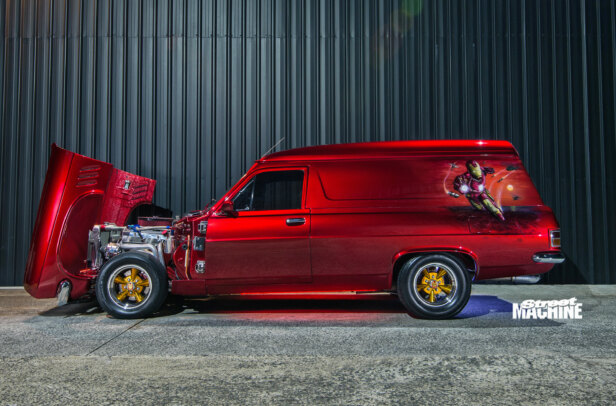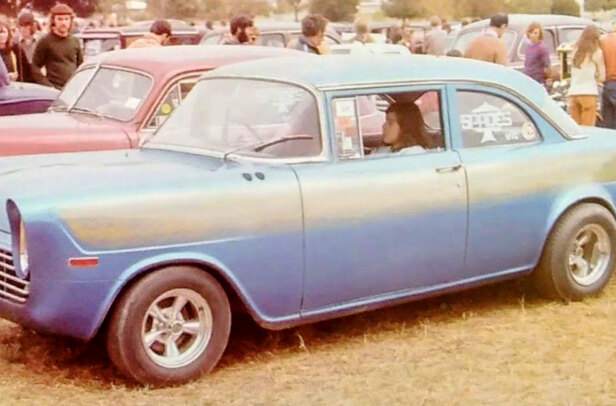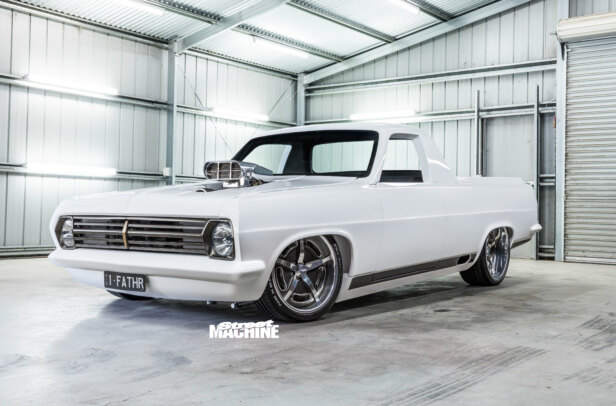Picture this. It’s 1967 and Paul Mullins’s grandad slings a bundle of hard earned bucks over the counter at his local Holden dealer and drives out in a brand new HR Special, complete with Powerglide transmission and the new 186 red motor. A pretty flash ride in those days! Many years later, when the old gent passed away, the HR had given 55,000 miles of faithful service and looked to be in pretty good nick. Young Paul couldn’t bear to see it sold off, so he acquired it for himself.
First published in the October 2002 issue of Street Machine

Fast forward to November 2001. Paul enters his newly-completed Pro Street HR in Adelaide’s premier car show, Extreme Horsepower. Up against the likes of Alan Lucas’s Monaro, the HR dominates the results, taking home Top Holden, Top Engine Bay, Top 30 Elite, Top Street Machine Overall and Grand Champion. This is one special car but how did it come to be?
“I drove it in standard form for a while, then did a Celica five-speed conversion,” says Paul. This proved to be a painful, but crucial lesson. “I had bought this cheap kit and it was a heap of shit! Nothing fitted and when I did get it to work, the result was awful. I made the decision right then that I would never do anything by halves. If I couldn’t afford to buy the right parts, I would wait.”
Looking at the finished result, it is easy to tell that Paul has lived by this doctrine to the letter – it’s damn near perfect!

As Paul scrimped and saved, a firm rebuild plan was formulated, which called for a monster driveline and big wheel tubs, but with factory-style paint, interior and panel work. Apart from the rims, gauges and shifter, the HR was to look like a neat stocker.
“I wanted to give the impression that I had taken a museum piece and hit it with the Pro Street treatment,” says Paul.
Looking at the finished product, you’d have to agree that he has achieved his aims, but not without a lot of blood, sweat and cold, hard cash. Turns out that the HR had more than its fair share of rust – so much so that apart from the shell, the only panels that could be retained were the bonnet, boot, one door and one guard.

Rather than throw his hands up in despair, Mr Mullins took strong and decisive action. New panels were acquired and the whole lot trucked up to local firm Minus Paint for a double dipping – once to dissolve all traces of paint, gunk and goo and another to “eat” offending sections of rust in all the hard-to-get-at places. Paul then hired a MIG and seam welded the entire car.
“I figured this would be a good idea considering the horsepower I wanted.” With this in mind, the car was sent to Road Performance Modifications, where street machine legend Mark Saunders fitted an ultra-sturdy pair of chassis rails, new trans tunnel and set of trick double-skinned wheel tubs.

The engineer also mandated that a pair of extra suspension links be fitted to prevent axle wind up under acceleration. Through the whole process, great care was taken to meet engineers requirements and to keep the car 100 per cent resistant to the dreaded tin worm.
With the chassis work complete, Paul took the car home, laid it on its side and smoothed any welding spatter with a wire-wheeled angle grinder. The super smooth undercarriage and interior were painted in easy-care black, the boot painstakingly boxed up in MDF, while any unused holes in the subframes and firewall were filled by a professional welder then smoothed by Paul.

We could spend ages detailing just how Paul achieved the ultra-smooth result. It will either inspire or depress you profoundly with the amount of work that’s gone into it! With perfection achieved, the body and dash were hit with luscious coats of Spies Hecker Fowler’s Ivory White two-pack – actually an EH colour.
Inside the cockpit. the swinging 60s feel is alive and well. The factory dash is unmolested, with only the addition of extra gauges to the steering column, some Premier dash strips and the flawless integration of a Sony Xplod head unit to the facia, which controls a hard-hitting audio system.

The hi-fi install and all wiring was performed by Paul, who just happens to be an electronics technician, and as well as almost totally hiding the wiring, he has included a few neat tricks. For example, the yet-to-be-fitted nitrous system is armed by pressing in the cigarette lighter. The handbrake warning lamp then lights up blue, complete with “Nitrous Armed” lettering. Way cool.
The interior furniture is essentially stock, with the addition of HK Premier rear seat, all trimmed in a combination of vinyl and aircraft woolblend. Stainless steel strips on the door trims to separate the vinyl and cloth, chromed hex head bolts and brand new window glass and rubber make this a masterpiece of detail.

With the car looking right, it was time to install the mouse motor – no easy task, since it’s tighter than a fish’s bum in there. And what a motor it is – an evil, 350 Chev small block with a dash of high tech. The block is an 010 unit with four bolt mains, fitted with an ARP stud kit. Internal hardware is top notch, with a LT-1 crank, Peter Schaffer massaged Bowtie heads, 10.5:1 TRW pistons, a bulletproof valve train and a wild Crane cam. Sitting on top of the Edelbrock Victor Junior manifold is a Barry Grant 775cfm Gold Claw carby.
Two hard-core fuel systems were installed in the car – one for avgas and another for the planned nitrous. Both systems are based on modified Holley Blue fuel pumps, -10 braided line and aircraft filters.

Getting the exhaust right was a vital factor in making the power he wanted. “I used 1 3⁄4-inch primaries to began with, but they showed up as a major restriction on the engine dyno, so we went up to 1 7/8-inch primaries, which opened her right up.”
The high tech comes in the form of a custom ignition system. The thinking is done by Haltech IG5 ECU, which takes inputs from a custom crank trigger, throttle position switch, engine rpm, coolant temp and exhaust gas temp. The ECU directs a pair of twin channel M&W igniters to fire four VS Commodore twin post coils. Phew!
The results speak for themselves – 531hp on Maxwell Motors engine dyno, but Paul says the engine program may have been a bit too successful.

“Mate, it’s just too wild for the street as it is. Once I race her and run some good numbers, I’ll put in a milder cam. It will still be heaps of fun – she only weighs just over 1300kg!”
Getting all the grunt to the ground effectively and reliably won’t be a problem. The driveline consists of a worked, full manual Powerglide, 4200rpm torque convertor, 3.5-inch tailshaft and Ford nine-inch with Strange 4.56-inch gears, aluminium carrier, Romac full spool and 31-spline Moser axles. Nothing likely to go bang in that lot!
Now he can’t wait to test out his beast at the dragstrip.

PAUL’S 350-INTO-AN-HR TIPS
- Check everything with your engineer!
- Fit a set of sturdy chassis rails from the rear spring hangers to front Y-arms
- Convert your steering to rack and pinion. Paul used a shortened, rear mounted VL unit
- Get a large custom radiator made
- Fabricate boxed engine mounts with internal crush tubes
- Fit a larger trans tunnel so correct pinion angle can be maintained
- Scallop the engine crossmember for sump clearance
- Measure, measure then measure again!
- Relocate the starter motor with a fabricated adaptor
- Relocate the wiper motor to allow the engine to sit as far back as possible
PAUL MULLINS
1967 HR HOLDEN
| Colour: | Fowler’s Ivory White two-pack |
| ENGINE | |
| Type: | 350ci Chev, four-bolt mains |
| Heads: | Bowtie |
| Intake: | Edelbrock Victor Jnr |
| Induction: | Barry Grant 775cfm Gold Claw |
| TRANSMISSION | |
| Gearbox: | Powerglide |
| Diff: | Ford F100 nine-inch, with 4.56 gears |
| Suspension: | Slammed two-inch (f), three-inch (r) |
| Shocks: | Pedders gas |
| Brakes: | HQ vented (f) with HJ calipers, Ford 11-inch drums (r) |
| Steering: | Shortened Commodore rack & pinion |
| INTERIOR | |
| Seats: | HR buckets, HK Premier rear |
| Wheel: | Repainted factory |
| Gauges: | Auto Meter |
| WHEELS & TYRES | |
| Rims: | Weld Racing, 3.5×15 (f) 10×15 (r) |
| Rubber: | Michelin 155/60/15 and BF Goodrich 295/50/15 |




Comments